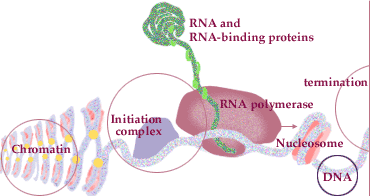
|
TranscriptionAfter transcription has been initiated RNA polymerase II, together with the necessary transcription elongation factors, travels along the DNA template and polymerizes ribonucleotides into an RNA copy of the gene. The polymerase moves at a regular speed (approximately 30 nucleotides per second) and holds on to the DNA template efficiently, even if the gene is very long (the human muscular dystrophy gene for example is 2.3 million base pairs long). At the end of the gene, the RNA polymerase falls off the DNA template and transcription terminates. |
||||||||||||||||||||
|
|
|||||||||||||||||||||